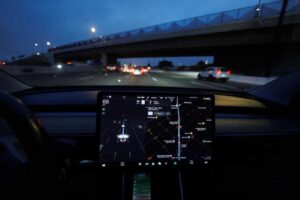
US auto-safety regulators said on Friday that their investigation into Tesla’s Autopilot had identified at least 13 fatal crashes in which the feature had been involved. The investigation also found the electric carmaker’s claims did not match up with reality.
The National Highway Traffic Safety Administration (NHTSA) disclosed on Friday that during its three-year Autopilot safety investigation, which it launched in August 2021, it identified at least 13 Tesla crashes involving one or more death, and many more involving serious injuries, in which “foreseeable driver misuse of the system played an apparent role”.
It also found evidence that “Tesla’s weak driver engagement system was not appropriate for Autopilot’s permissive operating capabilities”, which resulted in a “critical safety gap”.
The NHTSA also raised concerns that Tesla’s Autopilot name “may lead drivers to believe that the automation has greater capabilities than it does and invite drivers to overly trust the automation”.
Tesla said in December that its largest-ever recall, covering 2.03m US vehicles – or nearly all of its vehicles on US roads – was to better ensure drivers pay attention when using its advanced driver-assistance system.
After closing the first investigation, regulators opened another, this one into whether that recall to install new Autopilot safeguards was adequate.
The NHTSA said it was opening the second investigation after identifying concerns due to crash events after vehicles had had the recall software update installed “and results from preliminary NHTSA tests of remedied vehicles”.
That recall investigation covers models Y, X, S, 3 and Cybertruck vehicles in the US equipped with Autopilot and produced in the 2012 to 2024 model years, NHTSA said.
The agency said Tesla has issued software updates to address issues that appear related to its concerns but has not made them “a part of the recall or otherwise determined to remedy a defect that poses an unreasonable safety risk”. The NHTSA also cited Tesla’s statement “that a portion of the remedy both requires the owner to opt in and allows a driver to readily reverse it”.
Tesla said in December that Autopilot’s software system controls “may not be sufficient to prevent driver misuse” and could increase the risk of a crash.
Tesla did not immediately respond to a request for comment.
In February, Consumer Reports, a non-profit organization that evaluates products and services, said its testing of Tesla’s Autopilot recall update found that changes did not adequately address many safety concerns raised by the NHTSA and urged the agency to require the automaker to take “stronger steps”, saying Tesla’s recall “addresses minor inconveniences rather than fixing the real problems”.
Tesla’s Autopilot is intended to enable cars to steer, accelerate and brake automatically within their lane, while enhanced Autopilot can assist in changing lanes on highways but does not make vehicles autonomous.
One component of Autopilot is Autosteer, which maintains a set speed or following distance and works to keep a vehicle in its driving lane.
Tesla said in December it did not agree with the NHTSA’s analysis but would deploy an over-the-air software update that will “incorporate additional controls and alerts to those already existing on affected vehicles to further encourage the driver to adhere to their continuous driving responsibility whenever Autosteer is engaged”.
The NHTSA’s then top official, Ann Carlson, said in December that the investigation determined that more needed to be done to ensure drivers are engaged when Autopilot is in use. “One of the things we determined is that drivers are not always paying attention when that system is on,” Carlson said.
The NHTSA opened its August 2021 investigation of Autopilot after identifying more than a dozen crashes in which Tesla vehicles hit stationary emergency vehicles.
